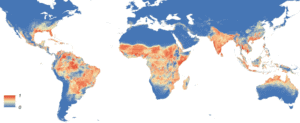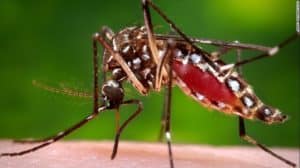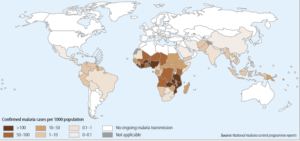As VIGILINT has reported, the 2016 Zika outbreak in Central and South America highlighted the threat posed by vector-borne diseases to governments, corporations, and travelers. With the ability to host a number of different diseases, mosquitos cause the deaths of hundreds of thousands of people worldwide each year. Increasing global temperatures create more mosquito-friendly habitats, widening the geographic range of mosquitos and increasing infection rates. While Zika remains a serious public health threat, the virus only accounted for a fraction of all mosquito-borne illness cases. Aside from Zika, chikungunya, dengue fever, malaria, and yellow fever are four of the most common and most concerning mosquito-borne illnesses.
CHIKUNGUNYA:
Chikungunya can be an exceptionally painful and debilitating disease transmitted by the Aedes family mosquito. Characterized by the sudden onset of high-grade fever and acute joint pain, chikungunya symptoms typically abate within two weeks. While the disease is rarely fatal, if left untreated, symptoms may develop into chronic joint pain and disability that lasts for months to years. Currently, there is no approved vaccine for humans.

Chikungunya is frequently found in urban areas. The virus was mainly found in Africa and Asia until 2013 when the first locally-transmitted cases of chikungunya in the Americas were reported in the Caribbean. The disease has since been transmitted locally in 45 countries. According to the Pan American Health Organization (PAHO), there have been 58,900 suspected cases (28,700 confirmed cases), including 13 deaths, of chikungunya in the Americas since the beginning of 2017. Although transmission in the U.S. is very rare, in 2014, cases were reported among U.S. travelers returning from affected areas in the Americas and local transmission was identified in Florida, Puerto Rico and the U.S. Virgin Islands.
DENGUE FEVER:
A startling 40% of the world’s population lives in areas at risk for dengue fever. Serologically similar to chikungunya, dengue is hosted by the Aedes mosquito and presents similar symptoms, making misdiagnosis common. Symptoms include high-grade fever, muscle and joint pain, headache, rash, and mild bleeding from the gums or nose. Five percent of dengue patients may develop a severe and potentially fatal form of the illness, known as Dengue Hemorrhagic Fever (DHF). Symptoms of DHF include severe abdominal pain, rapid breathing, persistent vomiting, and blood in vomit. DHF can induce organ failure, with approximately 2.5% of DHF cases resulting in death. There is no vaccine currently approved for travelers.

Although Zika made major headlines last year, it is dengue fever that is endemic in over 100 countries (compared to nine countries in 1970.) Cases have increased dramatically in the western Pacific and Southeast Asia. Sri Lanka and Laos are currently experiencing epidemic levels of dengue fever. The Epidemiology Unit of the Sri Lankan Ministry of Health reported 61,844 cases in 2017 as of June 13.
In recent news, an outbreak that began in December 2016 is still ongoing in Brazil. Between 01 January 2017 and 22 May 2017, Brazil has reported 144,000 suspected cases of dengue fever. According to PAHO, Brazil reported almost 1.5 million cases of dengue fever in 2016.
MALARIA:
Malaria is the most common vector-borne disease, causing 429,000 deaths in 2015. Spread by Anopheles family mosquitos, the classic symptom presentation of malaria is a cyclical occurrence of sudden coldness or chills, followed by rigor, then fever and sweating. This pattern typically occurs over a period of two to four days. If left untreated, malaria can be fatal. While there is currently no effective vaccine against malaria, travelers to countries where malaria is known to occur should consider proactive chemoprophylaxis (an antibiotic) to minimize risk. Most reported cases of malaria occur in regions with active transmission. As of 2015, 91 countries recorded ongoing malaria transmission. Travelers to sub-Saharan Africa are at the highest risk, where an estimated 88% of malaria cases occur.
According to PAHO, there were 240,613 malaria cases in Venezuela in 2016, with the municipality of Sifontes, Bolívar, accounting for 43% of total cases reported. Notably, Sifontes is a gold mining area, which has recently seen an influx of thousands of immigrants. Large population movements can produce conditions conducive for breeding and transmission.

Approximately 1,500 cases of malaria are diagnosed in the United States each year. There are few locally transmitted cases; the majority of cases are diagnosed in travelers returning from areas with active malaria transmission.
YELLOW FEVER:
Like chikungunya and dengue, yellow fever is a virus also transmitted by the Aedes mosquito. Symptoms include fever, chills, severe headache, body pain, vomiting, and fatigue. Approximately 15% of infected people will move into a second, toxic phase of the virus in the first 24-48 hours after initial symptoms begin to dissipate. These patients will experience high fever, jaundice, and abdominal pain with vomiting. Bleeding may occur in the mouth, eyes, or nose; blood may appear in the vomit and feces. The fatality rate in severe cases can reach to 50%. The yellow fever vaccine is recommended for travelers to South America and Africa and consists of one dose administered at least two weeks prior to travel. Notably, some countries require travelers to show proof of vaccination (Yellow Book) upon entry.
Travelers to Central and South America and Africa are at risk of Yellow fever virus transmission. In 2016, Angola and the Democratic Republic of the Congo experienced the world’s largest yellow fever outbreak in decades, with 965 confirmed cases and thousands more suspected cases.
Currently, Brazilian authorities are bracing for an urban outbreak of yellow fever, which could potentially infect a large population in a short time. Transmission has been confirmed in nine states: including Rio de Janeiro and São Paulo. PAHO reports 3,192 suspected yellow fever cases (758 confirmed), including 426 deaths (264 confirmed), in Brazil between December 2016 and 18 May 2017. An additional 34 confirmed cases have been reported in Brazil between 18 and 31 May 2017. Health officials in the city of Rio de Janeiro have activated an aggressive vaccination campaign to limit impact if urban transmission of the virus begins to occur.
PREVENTION:
Chikungunya, dengue, and malaria do not have effective vaccines and it is important that travelers are aware if these diseases are prevalent in their destinations. If you are going to an area where yellow fever has been reported, the CDC recommends getting vaccinated at least 10 days prior to your trip. Travelers should always practice aggressive anti-mosquito precautions, including avoiding rural areas and large bodies of untreated, standing water.
Education is imperative in mitigating the risk of contracting a mosquito-borne illness. VIGILINT’s Medical Contingency Plans can help identify areas with large disease carrying mosquito populations and provide vulnerability, probability, and consequence assessments. Travelers should remain aware of the threat of mosquito-borne illnesses and stay VIGILINT.
